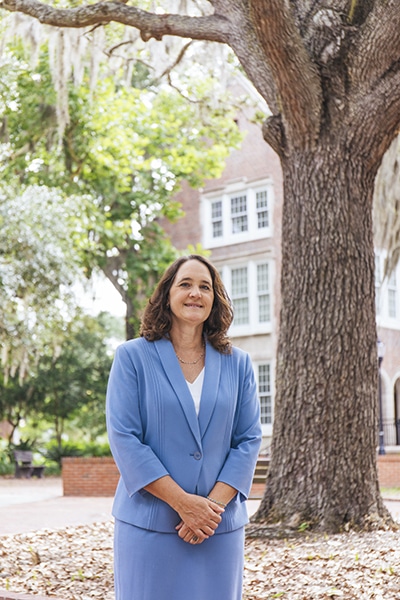|
Getting your Trinity Audio player ready...
|

A defining role of universities is to connect people and knowledge. By extension, university campus planning is about facilitating those connections in a very physical sense.
A new facility at the University of Florida in Gainesville known as DSIT—Data Science and Information Technology—will take that mission of connection a few steps further. When built, it will house researchers from several of the university’s colleges (medicine, pharmacy, engineering, and the Informatics Institute) which creates opportunity for multidisciplinary expertise to tackle certain problems.
The work of Linda Dixon, the university’s director of planning, celebrates the idea of connecting in many ways, figuratively and literally. DSIT is not just about an intersection of minds, although it promises to do that quite well. It’s also physically located in an infill site, “that stitches together our traditional campus to our academic medical campus,” she says. The 260,000-square-foot building will cost $150 million to construct and is expected to open in 2023.
The campus as a whole is undergoing an evolution, which is outlined in UF’s 2018 Landscape Master Plan and Campus Framework Plan, as well as plans for transportation, parking, and housing. Those plans go a long way toward honoring the existing attributes of the land grant university (founded in 1853, in Gainesville since 1906) while making it a thoroughly modern and inviting place, connected to the surrounding community and to enterprises far beyond the leaves and fronds of the 2,000-acre university grounds.
This school, whose sports teams are the Florida Gators, has a pretty strong history in birthing businesses. Gatorade sports drinks were created here.
In her role for almost 20 years, Dixon has won several statewide and national awards, and the 2018 plans might earn her a few more. It’s a heavy lift, one that balances the needs and interests of students, faculty, staff, and the surrounding community. The Plan honors the natural environment of native trees, sinkhole ponds, and a lake against new construction as well as historically significant buildings. It also navigates the budgetary constraints that all schools face.

Thus far the plan is well on its way to implementation, with several projects in various stages of development. This includes “gateway” roads leading into the campus, as well as a bicycle-pedestrian zone that allows people to move about campus without interference from autos and buses. A major academic building that received LEED Gold certification in 2020, Norman Hall has been renovated and given an addition to expand its program—accomplished in a way that didn’t challenge its status on the National Register of Historic Places.
The Plan’s prioritization of active transportation (walking and bicycling) might look inconsistent with the car culture more typically associated with Florida. But Gainesville and UF are different, the director notes.
“This city was unique in that it had a bicycle culture already in the 1960s,” Dixon says. “This was carried through the 1980s when Gainesville citizens persuaded the Florida Department of Transportation to hire the country’s first bicycle coordinator.” She acknowledges this coincided with a certain degree of sprawl at that same time, but development is beginning to return to the urban center in the 21st century. “Off campus housing is now closer in, making it more viable to get around by bike. We’re also seeing more ‘micro-mobility,’ with e-scooters, first-mile transit minibuses, and an autonomous shuttle.”

Paths and boardwalks serve as both a means of observing nature and providing contemplative spaces as they are corridors for getting around—connecting, not just diverting. These natural spaces are a source of pride for Gainesville residents and the tree canopy is important for walking and biking in the warm Florida climate.
Dixon characterizes the Master Plan as something that acknowledges that “landscape is the backdrop, within which the buildings are placed.” By this she refers to some features that northeastern Ivy League schools might envy: natural water bodies (sinkhole ponds and a lake) and largely native tree canopies (live oaks, bluff oaks, sycamores, magnolias, and cabbage palms). When a new building is constructed in this environment, architects and contractors have to “think outside the construction fence to integrate surrounding landscape and circulation systems,” she says. As throughout Florida, UF’s signature Lake Alice has alligators that evidently like their surroundings just fine.
But in the broader sense, the Plan and the idea of this university is to always think outside the physical barriers. Dixon observes that Gainesville, as with many college towns, will always have a somewhat transitory population. “But often people leave and then they come back,” she says. “It’s amazing how often you hear that story. There’s something here that draws people back.”
She interprets that this matters in her role as a designer and planner. “We try to keep important values at the forefront of the plan. It’s about identity—‘Gator Nation’ has 500,000 alumni—and we have to uphold that identity.”


